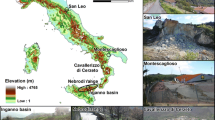Abstract
In recent years SAR interferometry has become a widely used technique for measuring altitude and displacement of the surface of the earth. Both these capabilities are highly relevant for landslide susceptibility studies. Although there are many problems that make the use of SAR interferometry less suitable for landslide inventory mapping, it’s use in landslide monitoring and in the generation of input maps for landslide susceptibility assessment looks very promising. The present work attempts to evaluate the usefulness and limitations of this technique based on a case study in the Swiss Alps. Input maps were generated from ERS repeat pass data using SAR interferometry. A land cover map has been generated by image classification of multi-temporal SAR intensity images. An InSAR DEM was generated and a number of maps were derived from it, such as slope-, aspect, altitude- and slope form classes. These maps were used to generate landslide and rockfall susceptibility maps, which give fairly well acceptable results. However, a comparison of the InSAR DEM with the conventional Swisstopo DEM, indicated significant errors in the absolute height and slope angles derived from InSAR, especially along the ridges and in the valleys. These errors are caused by low coherence mostly due to layover and shadow effects. Visual comparison of stereo images created from hillshading maps and corresponding DEMs demonstrate that a considerable amount of topographic details have been lost in the InSAR-derived DEM. It is concluded that InSAR derived input maps are not ideal for landslide susceptibility assessment, but could be used if more accurate data is lacking.




Similar content being viewed by others
References
Antonello G, Casagli N, Farina P, Leva D, Nico G, Sieber AJ, Tarchi D (2004) Ground-based SAR interferometry for monitoring mass movements. Landslides 1(1):21–28
Bonham-Carter GF(1994) Geographic Information Systems for Geoscientists. Modelling with GIS. Computer Methods in the Geosciences. Pergamon 13:267–302
Colesanti C, Ferretti A, Prati C, Rocca F (2003) Monitoring landslides and tectonic motions with the permanent scatterers technique. Eng Geol 68(1–2):3–14
Chips (2000) http://www.geogr.ku.dk/chips/Manual/f167.htm
Crosetto M (2002) Calibration and validation of SAR interferometry for DEM generation. ISPRS J Photogram Remote Sens 57:213–227
De Grandi GF, Leysen M, Lee JS, Schuler D (1997) Radar reflective estimation using multiple SAR scenes of the same target: techniques and applications. Proceedings of IGARRS Conference, Singapore, pp 1047–1050
Fruneau B, Achache J, Delacourt C (1996) Observations and modeling of the Saint-Etiemme-de-Tinee landslide using SAR interferometry. Tectonophysics 265:181–190
Gens R, van Genderen JL (1996) SAR Interferometry – Issues, Techniques, Applications. Int J Remote Sens 17:1803–1835
Holecz F, Pasquali P, Moreira J, Meier E, Nüesch D (1998) Automatic Generation and Quality Assessment of Digital Surface Models generated from AeS-1 InSAR data. Proceedings of European Conference on Synthetic Aperture Radar, Friedrichshafen, Germany
Kimura H, Yamaguchi Y (2000) Detection of landslide areas using satellite radar interferometry. Photogram Eng Remote Sens 66(3):337–344
Massonnet D, Feigl KL (1998) Radar interferometry and its application to changes in the earth’s surface. Rev Geophys 36(4):441–500
Pasquali P, Pellegrini R, Prati C, Rocca F (1994) Combination of interferograms from ascending and descending orbits. International Geosciences and Remote Sensing Symposium. Pasadena, CA, USA, pp 733–735
Pieraccini M, Casagli N, Luzi G, Tarchi D, Mecatti D, Noferini L, Atzeni C, (2003) Landslide monitoring by ground-based radar interferometry: A field test in Valdarno (Italy). Int J Remote Sens 24(6, 20):1385–1391
Platschorre Y (1997) A quantitative analysis of space borne derived elevation models. Unpublished M. Sc. Thesis, Delft University of Technology, 97 pp
Rabus B Eineder M, Roth A, Bamler R (2003) The shuttle radar topography mission–a new class of digital elevation models acquired by spaceborne radar. ISPRS J Photogram Remote Sens 57(4):241–262
Reigber A, Moreira J (1997) Phase unwrapping by fusion of local and global methods. Proceedings of IGARSS Symposium, Singapore
Rizo V, Tesauro M (2000) SAR interferometry and field data of Randazzo landslide (Eastern Sicily, Italy), Physics and Chemistry of the Earth, Part B: Hydrology. Oceans Atmos 25(9):771–780
Rosen PA, Hensley S, Joughin IR, Li FK, Madsen SN, Rodrıguez E, Goldstein RM, (2000) Synthetic aperture radar interferometry. Proce IEEE 88(3):333–382
Rott H, Scheuchl B, Siegel A, Grasemann B (1999) Monitoring very slow slope movements by means of SAR interferometry: a case study from a mass waste above a reservoir in the Ötztal Alps, Austria. Geophys Res Lett 26:1629–1632
Sarmap (2005) http://www.sarmap.ch/
Squarzoni C, Delacourt C, Allemand P (2003) Nine years of spatial and temporal evolution of the La Valette landslide observed by SAR interferometry. Eng Geol 68(1–2):53–66
Swisstopo (2002) http://www.swisstopo.ch/en/digital/dhm25.htm
Tarchi D, Casagli N, Moretti S, Leva D, Sieber AJ (2003) Monitoring landslide displacements by using ground-based synthetic aperture radar interferometry: Application to the Ruinon landslide in the Italian Alps. J Geophys Res B: Solid Earth 108(8):10–14
Van Westen CJ (1993) Application of Geographic Information Systems to Landslide Hazard Zonation. PhD Dissertation Technical University Delft. ITC Publication no. 15a, ITC, Enschede, the Netherlands, 245 pp
Acknowledgements
Part of this work was carried out in the framework of the DUP SLAM2 project “Service for Landslides Monitoring - Integration of Remote Sensing techniques with statistical methods for Landslide Monitoring and Risk Assessment” for the European Space Agency
We would like to thank Olivier Lateltin and Hugo Raetzo of the Swiss Federal Office for Water and Geology (FOWG) for providing us the landslide map of the study area, and Swisstopo for providing us the DHM25 Digital Elevation Model.
Author information
Authors and Affiliations
Corresponding author
Rights and permissions
About this article
Cite this article
Singh, L.P., van Westen, C.J., Champati Ray, P.K. et al. Accuracy assessment of InSAR derived input maps for landslide susceptibility analysis: a case study from the Swiss Alps. Landslides 2, 221–228 (2005). https://doi.org/10.1007/s10346-005-0059-z
Received:
Accepted:
Published:
Issue Date:
DOI: https://doi.org/10.1007/s10346-005-0059-z




